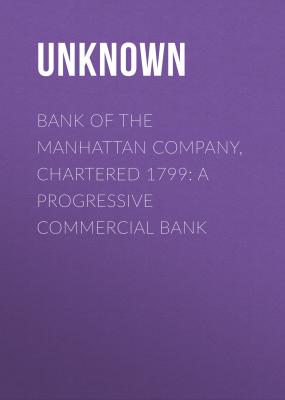Bank of the Manhattan Company, Chartered 1799: A Progressive Commercial Bank. Unknown
Читать онлайн.| Название | Bank of the Manhattan Company, Chartered 1799: A Progressive Commercial Bank |
|---|---|
| Автор произведения | Unknown |
| Жанр | Банковское дело |
| Серия | |
| Издательство | Банковское дело |
| Год выпуска | 0 |
| isbn |
Bank of the Manhattan Company, Chartered 1799: A Progressive Commercial Bank
Chief of the Manhattans
There are nine banks now in existence whose history reaches back into the Eighteenth Century. Of these, two are in Massachusetts, two in Connecticut, one in Pennsylvania, one in Delaware, one in Maryland and two in New York.
Corporate banking in New York began with the organization of the Bank of New York by Alexander Hamilton in 1784, which received its charter in 1792. For fifteen years this bank, together with the New York branch of the first Bank of the United States, were the only banks doing business in either the City or State of New York. With Hamilton and the Federals in control of the Legislature, new bank charters were unobtainable. This monopoly of banking facilities in the City and State was of great strategic value to the political party in control, and naturally aroused jealousy and resentment among the members of the opposition, whose leader was Aaron Burr.
EXCERPT FROM CHARTER
In 1798 New York City suffered from a severe yellow fever epidemic, which was attributed to an inadequate and inferior water supply. Upon the assembling of the Legislature in 1799, an association of individuals, among whom Aaron Burr was the moving spirit, applied for a charter for the purpose of "supplying the City of New York with pure and wholesome water." With a capital of $2,000,000, the project was an ambitious one for those days, and, as there was considerable uncertainty about the probable cost of the water system, a clause was inserted in the charter, permitting the Company to employ all surplus capital in the purchase of public or other stock or in any other monied transactions or operations, not inconsistent with the constitution and laws of New York or of the United States.
A great effort was made to defeat the charter on account of this clause granting the Company banking privileges. But the necessity for a proper water system, which could be procured only by the organization of a responsible company with large capital, carried it through the Legislature and it received the Governor's signature.
Конец ознакомительного фрагмента.
Текст предоставлен ООО «ЛитРес».
Прочитайте эту книгу целиком, купив полную легальную версию на ЛитРес.
Безопасно оплатить книгу можно банковской картой Visa, MasterCard, Maestro, со счета мобильного телефона, с платежного терминала, в салоне МТС или Связной, через PayPal, WebMoney, Яндекс.Деньги, QIWI Кошелек, бонусными картами или другим удобным Вам способом.
